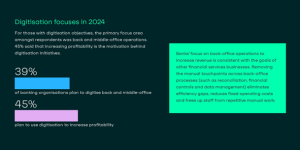Posted: 16/07/2024 | Read time: 4 minutes
Historically, banks held sway over retail finance and payment sectors, serving as the cornerstone of financial operations. However, with the rapid ascent of fintech, digital banking and technological advancements, the industry has diversified.
The resulting paradigm shift has given rise to a range of challenges and opportunities, including those in digital transformation.
Analysing our 2024 banking report, which surveyed 500 professionals across the UK and US banking industries, this blog will explore digital transformation – the priorities, challenges and trends in the banking industry.
Are firms prioritising digitisation?
Digitisation is a common goal shared across all financial service businesses. It allows firms to leverage technology to increase operational efficiency, flexibility to change and overall resilience.
However, the current state of digitisation is mixed across the banking industry. According to our survey, most organisations (two-thirds) are currently undertaking digitisation initiatives, albeit with varying progress.
Almost one-quarter consider the level of digitisation at their firm to be in place and fully matured, while just over 10% acknowledge they are yet to make progress.
Digitisation priorities
For those with digitisation objectives, the primary focus area among respondents was back and middle-office operations, with 39% of banking organisations planning to digitise them.
Notably, 45% said increasing profitability is the motivation behind digitisation initiatives. The focus banks have placed on back-office operations to increase revenue is consistent with the goals of other financial businesses.
This is because removing the manual touchpoints across back-office processes (such as reconciliation, financial controls and data management) eliminates efficiency gaps, reduces fixed operating costs and frees up staff from repetitive manual work.
Barriers to digitisation
While digitisation is a priority for many, roughly 30% of firms are yet to implement digitisation objectives.
Respondents indicated that their top barriers to digitisation were:
- Integration challenges (32%)
- Lack of internal skills (30%)
- Data security concerns (29%)
The three issues highlighted speak to a common issue in the banking industry: integrating new systems into an already complicated network of applications.
Banking organisations often have a range of systems, with a history of consolidation and old systems carrying over. The result is a network of different systems and fragmented data flows. Without significant legwork from staff, existing processes are simply incompatible with modern digital systems.
Further, a lack of internal skills exacerbates the problem. This is because adding new systems into a bank’s existing technology infrastructure requires meticulous data mapping between legacy and modern platforms.
Banks also need to develop robust API protocols to ensure seamless communication between systems and establish stringent cybersecurity measures to protect sensitive financial information. However, training or recruiting staff to take on such projects presents an operational burden in and of itself.
So, while banks are aware of the need to digitise, firms face many challenges that make digital transformation challenging.
Opportunities for digital transformation
It’s evident that the fintech and digital banking space, with its relentless pursuit of market share, poses a formidable challenge to traditional banking models. To keep pace, banks need to replace legacy systems, address any efficiency gaps and digitise outdated processes.
If they fail to do so, banks risk regulatory non-compliance, increased operational risk and inaccurate financial reporting.
But what (and where) are the opportunities for digital transformation?
- Process automation – streamlining manual processes and removing manual inefficiencies offers a chance to increase efficiency and scalability and reduce costs.
- Record logging – effective, automated logging of electronic records is critical for maintaining an audit trail. Our survey found that one in seven firms acknowledge they lack the necessary controls and record logging to satisfy audit requirements.
- Reconciliations – replacing manual intervention with end-to-end automation presents an opportunity eliminate much of the friction around reconciliations, while reducing operational cots and liberating staff from repetitive manual data work.
With 78% of respondents considering their firm too reliant on spreadsheets – and 70% agreeing their data lacks flexibility and transparency – investing in agile, adaptable and automated infrastructure is paramount if banks wish to be proactive.
Summary
- Two-thirds of organisations are undertaking digitisation initiatives, albeit with varying progress.
- 39% of banking organisations plan to digitise back and middle-office operations.
- 45% plan to use digitisation to increase profitability.
- Integration challenges (32%), lack of internal skills (30%) and data security concerns (29%) are the top 3 barriers to digitisation.
- Automation provides an opportunity for banks to react proactively and implement agile infrastructure.
For more insights into banking trends in 2024, read the full banking report here. Alternatively, view our dedicated banking hub to discover more about how AutoRek can enhance audibility, reduce operating costs and increase efficiency.

